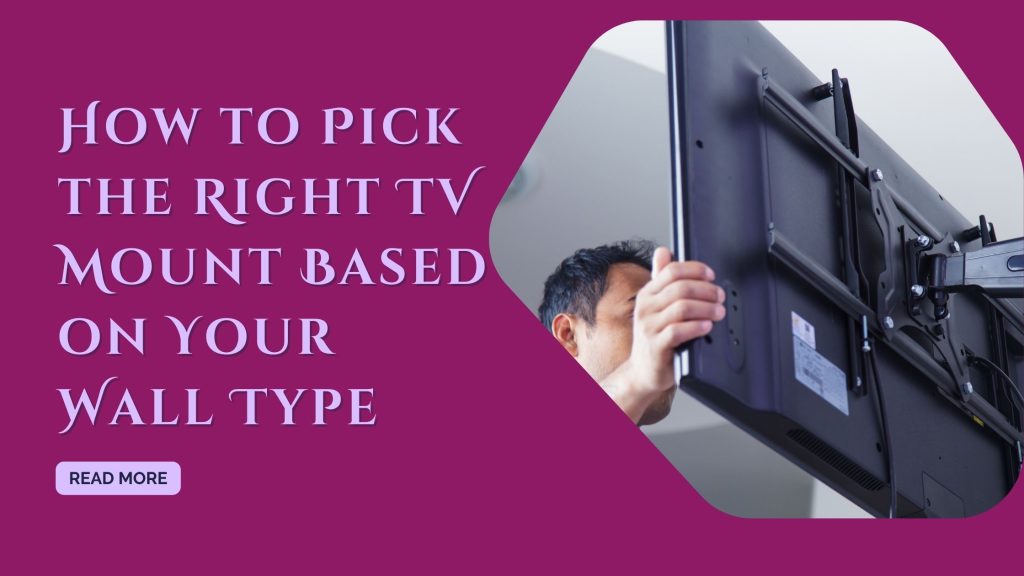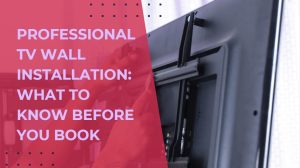Mounting a TV can greatly enhance the aesthetics of your room, provide better viewing angles, and free up space. However, selecting the right TV mount isn’t as simple as picking one off the shelf. The type of wall you have in your home plays a crucial role in choosing the easiest TV wall mount to install. Whether you’re dealing with drywall, concrete, brick, or wood, each material comes with its own challenges that require specific mounts and tools. This guide will help you pick the right TV mount based on your wall type, ensuring a safe, secure, and smooth installation.
Understanding Different Wall Types and Their Challenges
Before diving into specific TV mount recommendations, it’s important to understand the various wall types and the challenges they present when it comes to mounting a TV:
- Drywall: The most common wall type, but it requires extra attention to ensure the mount is securely anchored. Drywall alone is not strong enough to hold the weight of a TV, so it’s essential to locate studs.
- Brick, Concrete, or Stone: These materials are solid and sturdy, but drilling into them requires specialized tools and anchors.
- Wood or Metal Studs: These offer a solid structure for TV mounts, but the size and placement of the studs will affect the type of mount you can use.
- Plaster: Similar to drywall, but much thicker and potentially more difficult to work with when mounting.
Each wall type requires different mounting hardware and techniques, which is why selecting the best TV wall mount for drywall or other specific wall types is crucial.
Best TV Mounts for Drywall Installation
When installing a TV mount for drywall, the most important factor is finding the studs. Without them, the weight of the TV could tear the drywall. Fortunately, there are mounts specifically designed for drywall installations that make this process easier. The easiest wall mount for TV on drywall typically includes the following features:
- Stud-Finding Capability: Some mounts come with built-in stud finders or suggestions for stud placement.
- Weight Capacity: Ensure the mount is rated to hold the weight of your TV, typically rated in pounds.
- Simplicity: A simple TV wall mount design is often the easiest to install and can work well for flat-screen TVs without additional adjustments like tilting or swiveling.
When installing on drywall, consider a fixed TV mount. These mounts keep your TV securely in place and don’t require the flexibility of tilting or swiveling, making them perfect for simple installations.
Mounting a TV on Brick, Concrete, or Stone Walls
Mounting a TV on a brick, concrete, or stone wall presents a unique set of challenges. These materials are incredibly strong, but drilling into them requires the right tools. Here’s how to approach mounting a TV on these surfaces:
- Drilling: You’ll need a powerful hammer drill with a masonry bit to create the holes for the anchors. Regular drills are not suitable for this task.
- Anchors: Use concrete or masonry anchors that are specifically designed for these surfaces. These anchors help secure the TV mount and prevent it from coming loose.
- Mount Type: For brick or concrete, you’ll want a sturdy, heavy-duty TV mount that can support the weight of your TV. A full-motion mount or tilting mount might be ideal, as they can adjust for optimal viewing angles.
Be sure to measure carefully and ensure that the mount is level before drilling into the surface, as it’s harder to fix mistakes with stone and concrete walls.
How to Secure a TV on Metal or Wood Stud Walls
If you have wood or metal stud walls, you’ll need to find the studs behind the drywall to securely mount your TV. Here’s what you need to know:
- Wood Studs: Wood studs are strong and can easily support a TV mount. Use wood screws and ensure they’re long enough to penetrate the studs deeply.
- Metal Studs: Metal studs are thinner and may not support the weight of a large TV on their own. For metal stud walls, you’ll need special anchors, like toggle bolts, to securely attach the mount.
A best large TV wall mount would be ideal for metal or wood stud walls, as it can typically support heavier TVs. Make sure to properly locate the studs before installation and use a stud finder to ensure the accuracy of the placement.
Choosing Between Fixed, Tilting, and Full-Motion Mounts
When choosing a television mount, you have several options, each of which is suited for different viewing experiences and wall types:
- Fixed Mounts: These mounts hold your TV flat against the wall. They are the simplest and easiest TV wall mount to install, as they don’t require any adjustment after installation. Fixed mounts are perfect for those who want their TV to remain stationary and don’t need the ability to change angles.
- Tilting Mounts: These mounts allow you to adjust the tilt of your TV up or down. This is ideal for reducing glare or improving the viewing angle, especially if the TV is mounted high on the wall. A tilting mount is great for most wall types, especially drywall.
- Full-Motion Mounts: These are the most flexible TV mounts, as they allow you to swivel, tilt, and extend your TV from the wall. They are ideal for larger rooms where you need the flexibility to change the viewing angle. A best large TV wall mount is often a full-motion mount, as it can support bigger, heavier TVs and allows you to move them into different positions for better viewing.
Choosing between these options comes down to how much flexibility you need. If you prefer a simple TV wall mount and don’t need adjustments, a fixed mount is the best choice. For those seeking more versatility, a tilting or full-motion mount is ideal.
Essential Tools and Safety Tips for a Secure Installation
No matter what wall type you have, there are essential tools you’ll need for a secure TV mount installation:
- Stud Finder: Essential for locating the studs in drywall, wood, or metal stud walls.
- Level: Ensure your TV is mounted straight to avoid crooked displays.
- Hammer Drill (for masonry walls): If you’re mounting on brick, concrete, or stone, a hammer drill with masonry bits is essential.
- Screws and Anchors: Use the right screws and anchors based on your wall type (drywall anchors for drywall, masonry anchors for brick and concrete, etc.).
- Power Drill: For wood and metal stud installations, a power drill will help drive screws into the studs.
Safety Tips:
- Check TV Weight: Ensure that the mount you choose can handle the weight of your TV.
- Double-Check Wall Integrity: Before drilling, make sure the wall is strong enough to support the mount and TV.
- Secure Cables: Use cable management solutions to keep wires hidden and organized after the mount is installed.
By selecting the best TV mount for your wall type and following proper installation procedures, you can ensure that your TV is mounted safely and securely for years to come.






